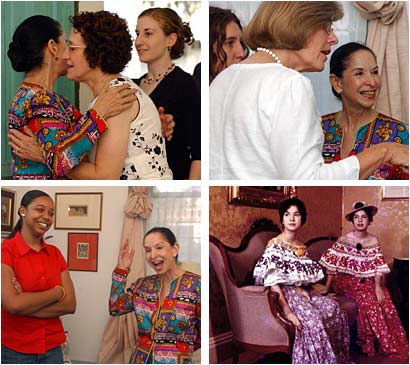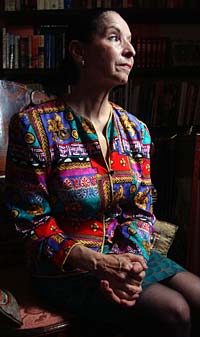Dance of Life: Olga Guardia Smoak '61
“I’ll try.” For Olga Guardia Smoak ’61, this is no simple statement; it’s a pledge. Whether she’s taking on a seemingly insurmountable challenge or delving into an unknown world, Smoak exhibits tenacity, dedication, and passion that have become legendary.
One of two daughters born to a distinguished waterworks engineer in Panama, Smoak temporarily moved to Chicago with her parents and sister Gloria Guardia ’62 when she was 14. She had always been a dedicated student, as well an avid ballet dancer, and nothing less was expected of her in her new home. “My father was loving, but demanding,” she revealed. “He would tease, ‘You are not going to let a “little thing” like not knowing English keep you from being the best in the class.’” And it didn’t. But at the end of her high school years, Smoak had to decide whether to go to college or begin a professional ballet career. (On average, female ballet dancers enter a company at the age of 18.) She chose the former, and after visiting the campus and interacting with alumnae, decided on Vassar.
Since Vassar at the time did not have a ballet program, Smoak had to stop classical dancing altogether. To choose college over ballet was wrenching, but, in retrospect, the correct decision. In the end both choices fused.
Vassar, for Smoak, was a “feast.” A French comparative literature major, she also took classes in Spanish literature, history of drama, English, philosophy, and Russian. Smoak graduated from Vassar convinced of three vital “truths.” “One, my mind was just as good as a man’s; two, I had continually to expand my intellect and do something with it; and three, with a liberal education as the basis and commitment to a worthy goal I could do anything. Mind you, at Vassar this positive trilogy was pounded into you. If you were a Vassar graduate, you could go out into the world and slay dragons,” Smoak recalled.
In 1965, as a newlywed whose husband worked for the U.S. Government in New Orleans, Smoak landed in that charming city. As a way of getting to know her new town and its residents, she joined the local Vassar club. There she met Rubie Crosby Bell ’47, who asked her to help in recruiting efforts for Vassar. “I’ll try,” Smoak replied. “I thought to myself, I want to be like Mrs. Harry [Jean Harry ’33, the director of Vassar admission, whose enthusiasm had greatly influenced Smoak’s decision to attend]. I want to be the person who walks into a school and who makes an impact on students, because I am telling them about something that made a difference in my life,” she said. From 1970 to 1975, Smoak recruited approximately 80 students from her region. She went into schools that were not traditionally recruited by Vassar and talked to top students. At De La Salle High School, she spoke with John Lawrence and Xavier Castellanos, who both graduated from Vassar in 1975. Once her recruits became Vassar students, Smoak pulled them back in to use as examples for further recruiting. (Castellanos persuaded his brother Paul ’79 to make the move to Poughkeepsie.) Kim Landsman ’74, who transferred from Tulane to Vassar, said that the Office of Admission once told him that there was a disproportionate number of New Orleans students during this time because of Smoak. He remembered leaving his interview with her thinking, “If this is the type of person who went to Vassar, I want to be there.” And he credited Smoak for steering him to “one of the best decisions I have ever made.” Smoak has been one of Vassar’s biggest cheerleaders and arguably its most effective recruiter to date. Margaret O’Meara Correro ’63, who worked with Smoak on recruiting efforts, agreed, “When speaking of Olga, superlatives are in order.”

In 1975 Smoak embarked on another journey, combining her knowledge and love of dance and the persuasive skills she honed while recruiting for Vassar. When the Bolshoi Ballet came to New Orleans, Smoak went to all the performances. It filled her with regret at having left dance behind during her college years. Smoak followed the dance company across the United States, sitting in the audience and eventually getting to meet two of the star performers, Ludmila Semenyaka and Mikhail Lavrovsky. The three became fast friends, and eventually the dancers sought out Smoak’s help. Since Soviet dancers’ travel and access to the press was restricted, the dancers asked if she could help get them interviews. Smoak’s immediate reply was the familiar: “I’ll try.” Her first attempt to arrange interviews failed because a Russian translator could not be found in time. Undaunted, Smoak vowed to brush up on the Russian she learned at Vassar, so she’d never have to face that complication again. Then she took her dedication a step further.
In New Orleans, Smoak had been doing work for the local PBS station. She approached the director with the idea of producing a piece on the Bolshoi Ballet, using her connections to get behind the scenes. She was told, “This is terrific, go get it approved.” But approval meant traveling to Moscow alone and meeting with the Ministry of Culture, to obtain permission to film inside the Soviet Union. She flew to Moscow and obtained her goal. But even with the proper permission, the local PBS affiliate was unable to raise the funds for the ballet series. Smoak concluded, “I have to do this, even if it doesn’t get on PBS. No one had ever filmed [the Bolshoi’s] classes, their rehearsals, coaching sessions. Getting something like this was like breaking through a tremendous barrier and an opportunity not to be lost.” So she traveled to Paris, where the ballet was on tour. Staying in a friend’s apartment across from the theater, Smoak spent three months attending every class and performance and traveling with the company while a friend filmed the promised footage. (The films, although never produced by PBS, have been used countless times over the years by companies, ballet schools, and dance history courses and are currently housed in the University of Southern California in the Dwight Grell Collection.)
In Paris, Smoak was approached by two dancers from the Bolshoi who asked her to arrange to have them invited to the United States by a dance company. (At the time, dancers were not allowed to travel apart from the official company.) Knowing well the local Delta Festival Ballet of New Orleans, Smoak contacted its director and asked if Delta would be interested in hosting prima ballerina Natalia Bessmertnova and her Bolshoi partner Lavrovsky for two company galas. The Delta director responded enthusiastically, “This is impossible...you can do that?” Smoak, of course, said, “I’ll try.” Miraculously for 1977, approval was obtained, and so began Smoak’s extraordinary career in the dance world.
As she continued to manage and arrange travel for Soviet dancers and teachers to perform internationally, her reputation grew by word of mouth in the dance world. It was a matter of being in the right place at the right time, she said. “I wasn’t even aware of how it was snowballing, how it was carrying its own momentum.” She took U.S. dancers to the Soviet Union; obtained permission from the Gershwin Foundation for a company of Soviet Georgia to perform Porgy and Bess; arranged for the choreographer Miguel Lopez, who had taught for Alvin Ailey, to teach modern dance at the Bolshoi; and coordinated trips for dance writers and critics from three continents to meet artists and attend performances. By facilitating communication between these cultures, she opened up the mysteries of the craft of Russian dance to the West, while also helping to introduce new techniques, styles, and music from West to East. As Smoak told a New York Times reporter in 1986, she firmly believes that “people who share an art do not have any differences.”

Over the years, Smoak’s professional life has connected with her Vassar roots. On a 1983 trip to the Soviet Union, which she had helped organize, she encountered Mindy Aloff ’69, who at the time was a senior critic for Dance magazine as well as editor of the Vassar Quarterly. Aloff recalled, “I’d already had a lot of exposure to Russian ballet and its history from touring companies and my reading. But it was fantastic to sit in what had been the Mariinsky Theatre.” (The Tsarist-founded Mariinsky Theatre later changed its name to the Kirov Theatre in the 1930s and is now back to being named the Mariinsky.) For that trip, Smoak also arranged interviews with dancers and viewing of classes and rehearsals. Also around that time, Smoak met Debra Jackson ’84 in a ballet class in New Orleans. Jackson was an undergraduate at Xavier University, and Smoak immediately set out to recruit her for Vassar. “I was a frequent visitor at Olga’s house,” Jackson recalls, “often staying late into the night, talking with her about Russian ballet and her experiences with the Bolshoi on tour.” (Eventually, Jackson became more like a family member than a recruit—so much so that when Jackson was married at the Vassar Chapel this year, Smoak’s husband James walked the bride down the aisle.) Jackson traveled with Smoak to Russia and elsewhere, helping whenever needed. Their most recent collaboration was during the 2000 New Orleans International Ballet Conference symposium, Dancing Through History, which Olga organized. “It was a major milestone for Olga and for the city of New Orleans,” said Jackson. The conference was under the patronage of the International Dance Council of the United Nations Educational, Scientific and Cultural
Organization (CID/UNESCO), and it honored the bicentennial of the Louisiana Purchase. “I got on the phone with dancers all over the world and said, ‘You are coming here to dance, and you are donating your services’—and they came,” said Smoak. CID/UNESCO had singled out a previous 2000 conference Smoak organized on the Ballets Russes as the best in North America, and the executives at CID/UNESCO said, “You’ve got to do it again.” Smoak obliged; she continues to help coordinate and preside over a triennial conference, under the New Orleans International Ballet Conference.
From 1992 to 1996 Smoak worked in Moscow, where she translated and edited the English version of Russia’s Ballet magazine, and helped organize fundraising for gala performances at the Bolshoi and Kremlin Palace. Smoak spends more time at home in New Orleans these days. But she is hardly resting. Aside from chairing one of the CID/UNESCO committees and representing the USA Jackson International Ballet Competition, she teaches a history of dance course at Loyola and brings together American Ballet Theatre stars and other international stars for local and international productions and competitions. And she is still up to her old tricks, recruiting for Vassar. “This year I found out how few students had applied from the area. Somebody I know mentioned that her daughter is very bright. So I said, ‘Why don’t you have her apply to Vassar?’”
Admittedly, she says, “I have always done something when it is asked of me. If you think, ‘This doesn’t make sense, nobody has every done it,’ you would surely hesitate before plunging in. But if someone is depending on you, and if Vassar programmed you to ‘slay dragons,’ you just do it.” Or, if you’re Olga Smoak, you at least try.
